Do you have a question about the Cessna T182 1982 and is the answer not in the manual?
Warning regarding Pitot heater operation in Instrument Meteorological Conditions below 40°F.
Diagram illustrating the three-view dimensions of the Cessna Model T182.
Introduction to Section 1, outlining its scope and content.
Detailed descriptive data for the engine and propellers.
Information on recommended oil grades, specifications, and viscosity for the engine.
Maximum allowable weights for ramp, takeoff, and landing, including baggage compartment limits.
Standard empty weights and maximum useful loads for different models.
Definitions of common airspeed terms and symbols like KCAS, KIAS, KTAS, VA, VNO, VNE, VS, VX, VY.
Definitions of engine power terms such as BHP, RPM, and MP.
Definitions of weight and balance terms like Station, Arm, Moment, CG, CG Limits, Empty Weight, Useful Load.
Introduction to Section 2, covering operating limitations, instrument markings, and placards.
Table showing airspeed limitations (VNE, VNO, VA, VFE) and their operational significance and values.
Description of airspeed indicator markings (white arc, green arc, yellow arc, red line) and their significance.
Color code significance for power plant instrument markings like Tachometer, Manifold Pressure, Oil Temp, etc.
Maximum allowable weights for ramp, takeoff, and landing, including baggage compartment limits.
Specifies flight load factors for flaps up and flaps down conditions.
States the certificated maximum operating altitude for the airplane.
Details required placards for pilot view, near airspeed indicator, control lock, fuel selector, baggage door, and flap indicator.
Amplified procedures for engine failures, forced landings, fires, and other emergencies.
Lists recommended airspeeds for various emergency operations like engine failure and forced landings.
Checklists for engine failure during takeoff roll, immediately after takeoff, and during flight restart procedures.
Step-by-step procedure for performing a precautionary landing with engine power.
Procedure to follow in case of an engine fire during flight.
Procedure to follow in case of a cabin fire.
Steps to take during an inadvertent encounter with icing conditions.
Details malfunctions in the electrical system, including excessive rate of charge and low voltage.
Procedures for executing an emergency descent in smooth and rough air conditions.
Amplified procedures and guidance for engine failure scenarios, including glide information.
Detailed procedures for preparing and executing forced landings, including ditching considerations.
Procedures for operating in clouds when the vacuum system fails, affecting attitude and directional indicators.
Step-by-step procedure for recovering from a spiral dive.
Guidance on handling inadvertent encounters with icing conditions.
Procedures and causes for rough engine operation or loss of power, including carburetor icing.
Procedure to follow in case of an engine-driven fuel pump failure.
Details malfunctions in the electrical system, covering excessive and insufficient rates of charge.
Amplified procedures for preflight inspection, starting engine, taxiing, and takeoff.
Lists recommended airspeeds for takeoff, climb, and landing approaches.
Diagram illustrating the walk-around preflight inspection points.
Detailed checklist for preflight inspection of the cabin and empennage.
Preflight inspection steps for the right wing trailing edge.
Checklist for actions to perform before starting the engine.
Step-by-step procedure for starting the engine.
Procedures for performing normal and short field takeoffs.
Procedures for normal and maximum performance enroute climbs.
Procedures for normal, short field, and balked landings.
Steps to take after landing the aircraft.
Amplified details on preflight inspection, including checks for outside storage and rough field operation.
Amplified details and notes on starting the engine, including cold weather considerations.
Diagram showing correct taxiing procedures, including control inputs for different wind conditions.
Detailed procedure for checking magneto operation before takeoff.
Recommended wing flap settings for normal and soft field takeoffs.
Procedures and considerations for normal cruising flight, including power settings and cowl flaps.
Table showing cruise performance data (KTAS, NMPG) at different altitudes and power settings.
Description of stall characteristics, aural warning, and altitude loss during recovery.
Procedures and recommendations for operating the airplane in cold weather, particularly during starting.
Procedures for operating the engine in cold weather, including carburetor heat use, and hot weather considerations.
Recommendations for minimizing airplane noise impact on the public and noise levels for the Model T182.
Critical warning about the consequences of not following instructions for the gyro system.
Introduction to performance data charts, explaining their purpose and computation basis.
Takeoff distance data and corrections for wind effects, based on short field technique.
Cruise performance characteristics, power settings, and fuel flow data.
Calculation of fuel requirements for climb, including corrections for temperature and wind.
Landing distance data, similar to takeoff, with wind correction procedures.
Airspeed calibration data (KIAS vs KCAS) for flaps up, 20°, and full flap settings.
Airspeed calibration data for alternate static source and with optional air conditioning installed.
Chart for converting temperatures between Celsius and Fahrenheit.
Stall speeds in KIAS and KCAS for various conditions, including CG locations and flap settings.
Chart to determine wind components based on wind direction and runway.
Takeoff distance data for 3100 lbs weight under various conditions and temperatures.
Takeoff distance data for 2800 lbs and 2500 lbs weights under various conditions and temperatures.
Data showing maximum rate of climb in FPM at various altitudes and temperatures.
Data on time, fuel, and distance required for maximum rate of climb.
Data on time, fuel, and distance required for normal climb.
Cruise performance data (KTAS, GPH) at 2000 feet pressure altitude for various conditions.
Cruise performance data (KTAS, GPH) at 4000 feet pressure altitude for various conditions.
Cruise performance data (KTAS, GPH) at 6000 feet pressure altitude for various conditions.
Cruise performance data (KTAS, GPH) at 8000 feet pressure altitude for various conditions.
Cruise performance data (KTAS, GPH) at 10,000 feet pressure altitude for various conditions.
Cruise performance data (KTAS, GPH) at 12,000 feet pressure altitude for various conditions.
Cruise performance data (KTAS, GPH) at 14,000 feet pressure altitude for various conditions.
Cruise performance data (KTAS, GPH) at 16,000 feet pressure altitude for various conditions.
Cruise performance data (KTAS, GPH) at 18,000 feet pressure altitude for various conditions.
Cruise performance data (KTAS, GPH) at 20,000 feet pressure altitude for various conditions.
Chart showing aircraft range based on altitude, power setting, and fuel quantity.
Chart showing aircraft range based on altitude, power setting, and fuel quantity.
Chart showing aircraft endurance based on altitude and power setting.
Chart showing aircraft endurance based on altitude and power setting.
Landing distance data for short field technique under various conditions and temperatures.
Log for recording changes to aircraft weight and balance, including installed equipment.
List of aircraft items with their weight, arm, and moment values.
Introduction to Section 6, covering basic empty weight and moment procedures.
Diagram and form for calculating airplane weight and CG through weighing.
Template for recording continuous history of weight and balance changes.
Explanation of how to use performance data to operate within weight and CG limitations.
Description of baggage net, tie-down straps, eyebolts, and cargo loading instructions.
Diagrams showing CG locations for various occupant and baggage arrangements.
Diagrams illustrating cabin dimensions, door openings, and instrument panel layout.
Sample calculation form for determining aircraft loading and CG.
Continuation of the sample loading problem form for multiple configurations.
Graph used to determine moments for passengers and baggage based on weight and CG arm.
Chart used to plot aircraft weight and moment to determine CG envelope compliance.
Chart showing the allowable CG limits for the airplane at various weights.
Introduction to the equipment list, explaining item numbering, suffix letters, and column definitions.
Detailed list of powerplant and accessories with item number, reference drawing, weight, and arm.
Detailed list of landing gear, electrical systems, and related components.
Detailed list of aircraft instruments, including indicators and gauges.
Detailed list of instruments like altimeters, clocks, compasses, and engine gauges.
Description of the adjustable seats and child seat installation.
Description of seat belts, shoulder harnesses, and integrated systems with inertia reels.
Diagrams illustrating standard and integrated seat belt and shoulder harness systems.
Description of airplane entrance doors and cabin windows, including operation and latch design.
Description of the control lock system to prevent wind buffeting damage.
Description of controls for manifold pressure, mixture, and turbocharger waste gate.
Description of engine instruments, including oil pressure, oil temperature, cylinder head temperature, and EGT.
Description of the engine oil system, capacity, dipstick, and oil change procedures.
Description of the air induction system, including air filter, carburetor heat, and turbocharger airflow.
Description of the carburetor, idle cut-off, manual mixture control, and primer system.
Explanation of how manifold pressure changes with engine RPM in a turbocharged engine.
Considerations for operating a turbocharged airplane at different altitudes.
Description of the propeller system, including constant-speed governor and control.
Description of the fuel system, including tanks, selector valve, pumps, and strainer.
Notes regarding unusable fuel, fuel selector valve operation, and fuel tank venting.
Description of the single-disc, hydraulically-actuated brake system on each main wheel.
Description of the 28-volt DC electrical system, battery, alternator, and bus bars.
Schematic diagram of the airplane's electrical system, showing component connections.
Description of the split-rocker master switch and its functions.
Description of the alternator control unit and the low-voltage warning light.
Description of exterior lighting systems, including navigation, landing, taxi, strobe, and beacon lights.
Description of interior lighting systems, including panel, flood, post, and map lights.
Description of the cabin heating, ventilating, and defrosting system controls and airflow.
Diagram illustrating the airflow paths and controls for the cabin heating system.
Description of the pitot-static system, including heated pitot tube and static pressure alternate source valve.
Description of the airspeed indicator, its markings, and operation for true airspeed.
Diagram illustrating the vacuum system components and airflow.
Description of the attitude indicator, explaining its display of pitch and bank attitude.
Overview of avionics support equipment, including cooling fans and microphone-headset installations.
Explanation of static dischargers and their importance for radio communication in precipitation.
Information on the airplane's identification plate, including serial, model, and type certificate numbers.
Checklist for essential data, information, and licenses required in the airplane file.
Requirements for annual and 100-hour inspections as mandated by FAA regulations.
Description of Cessna's progressive care program for airplane inspection and maintenance.
Information on limited maintenance tasks that certified pilots can perform on their aircraft.
Procedures for safe ground handling, including towing, parking, and tie-down methods.
Procedures for longitudinally leveling the airplane using leveling screws and tire pressure.
Overview of servicing requirements, referencing the Service Manual for detailed intervals and procedures.
Procedures for changing engine oil and oil filter, including interval recommendations.
Approved fuel grades, tank capacities, servicing recommendations, and fuel additives.
Information on fuel contamination causes and procedures for detection and correction.
Cautionary notes regarding EGME compound mixing and handling to prevent fuel system damage.
Specifications for landing gear tire pressures and nose gear shock strut service.
Care recommendations for painted surfaces, including washing, waxing, and cold weather protection.
Recommendations for propeller preflight inspection, cleaning, and care to ensure blade life.
Procedures for cleaning the interior, including upholstery, carpet, leather, and plastic components.
Instructions for replacing defective light bulbs during flight without tools.
Introduction to Section 9, describing the purpose and organization of system supplements.
Description of the secondary seat stop system for the pilot's seat.
Diagrams illustrating the secondary seat stop lever and plate installation.
Procedure for testing the pilot's seat for proper operation during preflight inspection.
General description of the digital clock, its display, and controls.
Normal procedures for operating the clock and date functions of the digital clock.
Procedure for setting the correct date and time on the digital clock.
Instructions on how to operate the 24-hour elapsed timer function of the digital clock.
General description of the ground service plug receptacle and its purpose.
Limitations regarding the ground service plug receptacle, including voltage and polarity warnings.
Normal procedures for checking battery condition after using the ground service plug.
General description of the oxygen system, its components, and operation.
Warning regarding the fire hazard of lubricants contacting oxygen equipment.
Chart used to determine oxygen duration based on pressure, altitude, and number of occupants.
States that there are no changes to airplane limitations when the oxygen system is installed.
Normal procedures for using the oxygen system, including mask and hose selection and supply control.
General description of the strobe light system, its components, and controls.
Notes that strobe light installation results in a minor reduction in cruise performance.
General description of audio control panels, their types, and operational features.
Description of the COM AUTO audio selector switch for automatic NAV/COM audio matching.
Explanation of sidetone capability and operation for speaker and headset audio.
Note regarding potential audio feedback (squeal) with intercom and auxiliary mike.
Diagrams illustrating the operating controls for audio control panels.
Description of audio selector switches for directing receiver audio to speaker or headset.
States no changes to airplane limitations when audio control panels are installed.
Normal operating procedures for audio control panels, including transmitter and audio selector switches.
General description of the ELT system, its activation, and transmission capabilities.
Procedures for utilizing the ELT after a forced landing for emergency assistance.
Normal procedures for ELT operation, including automatic activation and inadvertent activation checks.
General description of the 300A Navomatic autopilot system, its components, and functions.
Diagram illustrating the operating controls and indicators for the autopilot system.
Description of the Course Deviation Indicator's role in autopilot navigation.
Description of the actuator's function in moving ailerons for autopilot control.
States the autopilot limitation that must be adhered to before takeoff and landing.
Procedure for selecting and holding a heading using the autopilot.
Procedure for tracking VOR or LOC courses using the autopilot.
General description of the Cessna 400 Transponder and Altitude Encoder system.
Diagram illustrating the operating controls for the transponder and altitude encoder.
Description of the reply lamp's function indicating transmission status and self-test operation.
States limitations for the encoding altimeter, requiring a backup barometric altimeter.
Procedures for transmitting Mode C altitude reporting codes, including setting altitude and selecting codes.
Guidance on recognizing and dealing with carburetor icing, including recommended procedures and warnings.
General description of the ice detector system's electronic circuit, sensors, and alarm functions.
Placard stating that flight operations are not to be predicated on the use of the carburetor ice detector.
Information on carburetor icing, including what to watch for and procedures.
Diagram showing the front panel controls and indicators of the Iceman carburetor ice detector.
Warning regarding Pitot heater operation in Instrument Meteorological Conditions below 40°F.
Diagram illustrating the three-view dimensions of the Cessna Model T182.
Introduction to Section 1, outlining its scope and content.
Detailed descriptive data for the engine and propellers.
Information on recommended oil grades, specifications, and viscosity for the engine.
Maximum allowable weights for ramp, takeoff, and landing, including baggage compartment limits.
Standard empty weights and maximum useful loads for different models.
Definitions of common airspeed terms and symbols like KCAS, KIAS, KTAS, VA, VNO, VNE, VS, VX, VY.
Definitions of engine power terms such as BHP, RPM, and MP.
Definitions of weight and balance terms like Station, Arm, Moment, CG, CG Limits, Empty Weight, Useful Load.
Introduction to Section 2, covering operating limitations, instrument markings, and placards.
Table showing airspeed limitations (VNE, VNO, VA, VFE) and their operational significance and values.
Description of airspeed indicator markings (white arc, green arc, yellow arc, red line) and their significance.
Color code significance for power plant instrument markings like Tachometer, Manifold Pressure, Oil Temp, etc.
Maximum allowable weights for ramp, takeoff, and landing, including baggage compartment limits.
Specifies flight load factors for flaps up and flaps down conditions.
States the certificated maximum operating altitude for the airplane.
Details required placards for pilot view, near airspeed indicator, control lock, fuel selector, baggage door, and flap indicator.
Amplified procedures for engine failures, forced landings, fires, and other emergencies.
Lists recommended airspeeds for various emergency operations like engine failure and forced landings.
Checklists for engine failure during takeoff roll, immediately after takeoff, and during flight restart procedures.
Step-by-step procedure for performing a precautionary landing with engine power.
Procedure to follow in case of an engine fire during flight.
Procedure to follow in case of a cabin fire.
Steps to take during an inadvertent encounter with icing conditions.
Details malfunctions in the electrical system, including excessive rate of charge and low voltage.
Procedures for executing an emergency descent in smooth and rough air conditions.
Amplified procedures and guidance for engine failure scenarios, including glide information.
Detailed procedures for preparing and executing forced landings, including ditching considerations.
Procedures for operating in clouds when the vacuum system fails, affecting attitude and directional indicators.
Step-by-step procedure for recovering from a spiral dive.
Guidance on handling inadvertent encounters with icing conditions.
Procedures and causes for rough engine operation or loss of power, including carburetor icing.
Procedure to follow in case of an engine-driven fuel pump failure.
Details malfunctions in the electrical system, covering excessive and insufficient rates of charge.
Amplified procedures for preflight inspection, starting engine, taxiing, and takeoff.
Lists recommended airspeeds for takeoff, climb, and landing approaches.
Diagram illustrating the walk-around preflight inspection points.
Detailed checklist for preflight inspection of the cabin and empennage.
Preflight inspection steps for the right wing trailing edge.
Checklist for actions to perform before starting the engine.
Step-by-step procedure for starting the engine.
Procedures for performing normal and short field takeoffs.
Procedures for normal and maximum performance enroute climbs.
Procedures for normal, short field, and balked landings.
Steps to take after landing the aircraft.
Amplified details on preflight inspection, including checks for outside storage and rough field operation.
Amplified details and notes on starting the engine, including cold weather considerations.
Diagram showing correct taxiing procedures, including control inputs for different wind conditions.
Detailed procedure for checking magneto operation before takeoff.
Recommended wing flap settings for normal and soft field takeoffs.
Procedures and considerations for normal cruising flight, including power settings and cowl flaps.
Table showing cruise performance data (KTAS, NMPG) at different altitudes and power settings.
Description of stall characteristics, aural warning, and altitude loss during recovery.
Procedures and recommendations for operating the airplane in cold weather, particularly during starting.
Procedures for operating the engine in cold weather, including carburetor heat use, and hot weather considerations.
Recommendations for minimizing airplane noise impact on the public and noise levels for the Model T182.
Critical warning about the consequences of not following instructions for the gyro system.
Introduction to performance data charts, explaining their purpose and computation basis.
Takeoff distance data and corrections for wind effects, based on short field technique.
Cruise performance characteristics, power settings, and fuel flow data.
Calculation of fuel requirements for climb, including corrections for temperature and wind.
Landing distance data, similar to takeoff, with wind correction procedures.
Airspeed calibration data (KIAS vs KCAS) for flaps up, 20°, and full flap settings.
Airspeed calibration data for alternate static source and with optional air conditioning installed.
Chart for converting temperatures between Celsius and Fahrenheit.
Stall speeds in KIAS and KCAS for various conditions, including CG locations and flap settings.
Chart to determine wind components based on wind direction and runway.
Takeoff distance data for 3100 lbs weight under various conditions and temperatures.
Takeoff distance data for 2800 lbs and 2500 lbs weights under various conditions and temperatures.
Data showing maximum rate of climb in FPM at various altitudes and temperatures.
Data on time, fuel, and distance required for maximum rate of climb.
Data on time, fuel, and distance required for normal climb.
Cruise performance data (KTAS, GPH) at 2000 feet pressure altitude for various conditions.
Cruise performance data (KTAS, GPH) at 4000 feet pressure altitude for various conditions.
Cruise performance data (KTAS, GPH) at 6000 feet pressure altitude for various conditions.
Cruise performance data (KTAS, GPH) at 8000 feet pressure altitude for various conditions.
Cruise performance data (KTAS, GPH) at 10,000 feet pressure altitude for various conditions.
Cruise performance data (KTAS, GPH) at 12,000 feet pressure altitude for various conditions.
Cruise performance data (KTAS, GPH) at 14,000 feet pressure altitude for various conditions.
Cruise performance data (KTAS, GPH) at 16,000 feet pressure altitude for various conditions.
Cruise performance data (KTAS, GPH) at 18,000 feet pressure altitude for various conditions.
Cruise performance data (KTAS, GPH) at 20,000 feet pressure altitude for various conditions.
Chart showing aircraft range based on altitude, power setting, and fuel quantity.
Chart showing aircraft range based on altitude, power setting, and fuel quantity.
Chart showing aircraft endurance based on altitude and power setting.
Chart showing aircraft endurance based on altitude and power setting.
Landing distance data for short field technique under various conditions and temperatures.
Log for recording changes to aircraft weight and balance, including installed equipment.
List of aircraft items with their weight, arm, and moment values.
Introduction to Section 6, covering basic empty weight and moment procedures.
Diagram and form for calculating airplane weight and CG through weighing.
Template for recording continuous history of weight and balance changes.
Explanation of how to use performance data to operate within weight and CG limitations.
Description of baggage net, tie-down straps, eyebolts, and cargo loading instructions.
Diagrams showing CG locations for various occupant and baggage arrangements.
Diagrams illustrating cabin dimensions, door openings, and instrument panel layout.
Sample calculation form for determining aircraft loading and CG.
Continuation of the sample loading problem form for multiple configurations.
Graph used to determine moments for passengers and baggage based on weight and CG arm.
Chart used to plot aircraft weight and moment to determine CG envelope compliance.
Chart showing the allowable CG limits for the airplane at various weights.
Introduction to the equipment list, explaining item numbering, suffix letters, and column definitions.
Detailed list of powerplant and accessories with item number, reference drawing, weight, and arm.
Detailed list of landing gear, electrical systems, and related components.
Detailed list of aircraft instruments, including indicators and gauges.
Detailed list of instruments like altimeters, clocks, compasses, and engine gauges.
Description of the adjustable seats and child seat installation.
Description of seat belts, shoulder harnesses, and integrated systems with inertia reels.
Diagrams illustrating standard and integrated seat belt and shoulder harness systems.
Description of airplane entrance doors and cabin windows, including operation and latch design.
Description of the control lock system to prevent wind buffeting damage.
Description of controls for manifold pressure, mixture, and turbocharger waste gate.
Description of engine instruments, including oil pressure, oil temperature, cylinder head temperature, and EGT.
Description of the engine oil system, capacity, dipstick, and oil change procedures.
Description of the air induction system, including air filter, carburetor heat, and turbocharger airflow.
Description of the carburetor, idle cut-off, manual mixture control, and primer system.
Explanation of how manifold pressure changes with engine RPM in a turbocharged engine.
Considerations for operating a turbocharged airplane at different altitudes.
Description of the propeller system, including constant-speed governor and control.
Description of the fuel system, including tanks, selector valve, pumps, and strainer.
Notes regarding unusable fuel, fuel selector valve operation, and fuel tank venting.
Description of the single-disc, hydraulically-actuated brake system on each main wheel.
Description of the 28-volt DC electrical system, battery, alternator, and bus bars.
Schematic diagram of the airplane's electrical system, showing component connections.
Description of the split-rocker master switch and its functions.
Description of the alternator control unit and the low-voltage warning light.
Description of exterior lighting systems, including navigation, landing, taxi, strobe, and beacon lights.
Description of interior lighting systems, including panel, flood, post, and map lights.
Description of the cabin heating, ventilating, and defrosting system controls and airflow.
Diagram illustrating the airflow paths and controls for the cabin heating system.
Description of the pitot-static system, including heated pitot tube and static pressure alternate source valve.
Description of the airspeed indicator, its markings, and operation for true airspeed.
Diagram illustrating the vacuum system components and airflow.
Description of the attitude indicator, explaining its display of pitch and bank attitude.
Overview of avionics support equipment, including cooling fans and microphone-headset installations.
Explanation of static dischargers and their importance for radio communication in precipitation.
Information on the airplane's identification plate, including serial, model, and type certificate numbers.
Checklist for essential data, information, and licenses required in the airplane file.
Requirements for annual and 100-hour inspections as mandated by FAA regulations.
Description of Cessna's progressive care program for airplane inspection and maintenance.
Information on limited maintenance tasks that certified pilots can perform on their aircraft.
Procedures for safe ground handling, including towing, parking, and tie-down methods.
Procedures for longitudinally leveling the airplane using leveling screws and tire pressure.
Overview of servicing requirements, referencing the Service Manual for detailed intervals and procedures.
Procedures for changing engine oil and oil filter, including interval recommendations.
Approved fuel grades, tank capacities, servicing recommendations, and fuel additives.
Information on fuel contamination causes and procedures for detection and correction.
Cautionary notes regarding EGME compound mixing and handling to prevent fuel system damage.
Specifications for landing gear tire pressures and nose gear shock strut service.
Care recommendations for painted surfaces, including washing, waxing, and cold weather protection.
Recommendations for propeller preflight inspection, cleaning, and care to ensure blade life.
Procedures for cleaning the interior, including upholstery, carpet, leather, and plastic components.
Instructions for replacing defective light bulbs during flight without tools.
Introduction to Section 9, describing the purpose and organization of system supplements.
Description of the secondary seat stop system for the pilot's seat.
Diagrams illustrating the secondary seat stop lever and plate installation.
Procedure for testing the pilot's seat for proper operation during preflight inspection.
General description of the digital clock, its display, and controls.
Normal procedures for operating the clock and date functions of the digital clock.
Procedure for setting the correct date and time on the digital clock.
Instructions on how to operate the 24-hour elapsed timer function of the digital clock.
General description of the ground service plug receptacle and its purpose.
Limitations regarding the ground service plug receptacle, including voltage and polarity warnings.
Normal procedures for checking battery condition after using the ground service plug.
General description of the oxygen system, its components, and operation.
Warning regarding the fire hazard of lubricants contacting oxygen equipment.
Chart used to determine oxygen duration based on pressure, altitude, and number of occupants.
States that there are no changes to airplane limitations when the oxygen system is installed.
Normal procedures for using the oxygen system, including mask and hose selection and supply control.
General description of the strobe light system, its components, and controls.
Notes that strobe light installation results in a minor reduction in cruise performance.
General description of audio control panels, their types, and operational features.
Description of the COM AUTO audio selector switch for automatic NAV/COM audio matching.
Explanation of sidetone capability and operation for speaker and headset audio.
Note regarding potential audio feedback (squeal) with intercom and auxiliary mike.
Diagrams illustrating the operating controls for audio control panels.
Description of audio selector switches for directing receiver audio to speaker or headset.
States no changes to airplane limitations when audio control panels are installed.
Normal operating procedures for audio control panels, including transmitter and audio selector switches.
General description of the ELT system, its activation, and transmission capabilities.
Procedures for utilizing the ELT after a forced landing for emergency assistance.
Normal procedures for ELT operation, including automatic activation and inadvertent activation checks.
General description of the 300A Navomatic autopilot system, its components, and functions.
Diagram illustrating the operating controls and indicators for the autopilot system.
Description of the Course Deviation Indicator's role in autopilot navigation.
Description of the actuator's function in moving ailerons for autopilot control.
States the autopilot limitation that must be adhered to before takeoff and landing.
Procedure for selecting and holding a heading using the autopilot.
Procedure for tracking VOR or LOC courses using the autopilot.
General description of the Cessna 400 Transponder and Altitude Encoder system.
Diagram illustrating the operating controls for the transponder and altitude encoder.
Description of the reply lamp's function indicating transmission status and self-test operation.
States limitations for the encoding altimeter, requiring a backup barometric altimeter.
Procedures for transmitting Mode C altitude reporting codes, including setting altitude and selecting codes.
Guidance on recognizing and dealing with carburetor icing, including recommended procedures and warnings.
General description of the ice detector system's electronic circuit, sensors, and alarm functions.
Placard stating that flight operations are not to be predicated on the use of the carburetor ice detector.
Information on carburetor icing, including what to watch for and procedures.
Diagram showing the front panel controls and indicators of the Iceman carburetor ice detector.
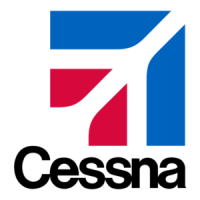
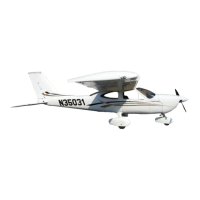
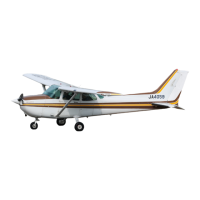
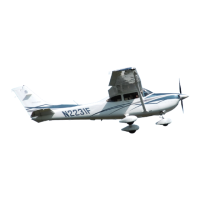

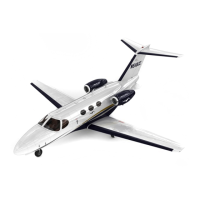
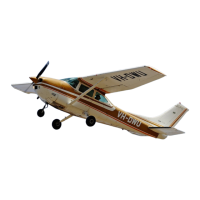
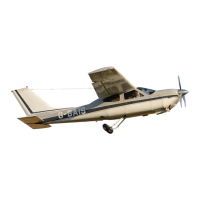

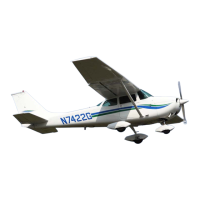


